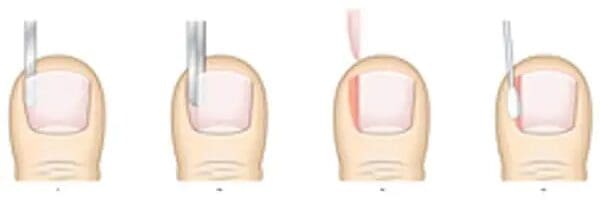Ingrown toenails are a common and painful condition that can severely impact your daily activities. If left untreated, the condition can worsen, leading to infection, swelling, and even long-term complications. The severity can vary from person to person, and early intervention is key to managing it effectively.
In this blog, we’ll explore the common causes of ingrown toenails, effective treatment options, and preventive measures to help you maintain healthy, pain-free feet.
What Is An Ingrown Toenail
An ingrown toenail, medically known as onychocryptosis, occurs when the edge of the toenail grows into the surrounding skin instead of growing outward. This condition commonly affects the big toe, leading to swelling, redness, and sometimes infection. Symptoms may vary depending on the severity of the condition.
People who suffer from this condition often look for ingrown toenail home treatment or professional care to remove the ingrown portion of the nail and prevent recurrence.
What Causes An Ingrown Toenail
Several factors can contribute to the development of ingrown toenails, including:
- Improper Nail Cutting – Trimming toenails too short or rounding the edges can cause the nail to grow into the skin.
- Tight Footwear – Narrow or tight-fitting shoes apply pressure on the toes, increasing the risk of ingrown nails.
- Injury or Trauma – Stubbing your toe, dropping something heavy on it, or repetitive stress from sports can alter nail growth.
- Poor Foot Hygiene – Failing to keep feet clean and dry can increase the risk of infections.
- Genetics – Some people naturally have curved or thick toenails, which may make them more prone to becoming ingrown.
- Swelling in the Feet (Oedema) – Conditions that cause fluid retention can lead to pressure on the toenails, pushing them into the skin.
If you notice pain, tenderness, or redness near the nail fold, addressing the issue early can prevent complications.
How To Treat Ingrown Toenails At Home
If your ingrown toenail is not infected, you can try home treatments before seeking professional care.
- Soak Your Foot in Warm Salt Water
Soaking your affected toe in a mixture of warm water and Epsom salt for 15-20 minutes may help reduce swelling and soften the skin. This makes it easier to lift the nail and relieve discomfort.
- Gently Lift the Nail
After soaking, use a clean piece of dental floss or cotton to gently lift the edge of the nail. This encourages the nail to grow outward instead of further into the skin.
- Apply an Antibiotic Ointment
Using antibiotic cream may help prevent infection and soothe irritation. After applying the ointment, cover the area with a clean bandage. Dressing the nail with betadine and bandage can reduce the risk of infection.
- Wear Comfortable Footwear
We recommend not to wear tight or pointed shoes that put pressure on the toes, until the issue is fixed. Opt for breathable, spacious footwear that allows your toes to move freely.
- Take Over-the-Counter Pain Relievers
If your ingrown toenail is painful, medications like ibuprofen or acetaminophen may help reduce discomfort and swelling.
If symptoms worsen, or if you see pus, excessive redness, or persistent pain, consult a podiatrist for ingrown toenail removal or other professional treatments.
Ingrown Toenail Treatment
If home remedies don’t improve the condition, seeking podiatric treatment is the next step.
- In-Clinic Podiatric Treatment For Ingrown Toenails
For mild to moderate cases, a podiatrist can carefully remove a small wedge of the nail or trim, or reshape the affected nail to improve the problem. The nail will need to be filed to ensure no further ingrown toenails occur. Antibiotics may be needed if there is infection.
- Surgical Treatment For Ingrown Toenails (For Severe Cases)
If the ingrown nail is severe, recurring, or infected, and conservative treatments haven’t worked, a partial nail avulsion may be needed.
- The procedure involves a small resection of the nail under local anesthesia, and Phenol treatment may be used to prevent regrowth of the ingrown portion.
- Following the procedure, adequate amounts of dressings are applied and reviewed by the podiatrist to ensure the area is being healed properly.
- The toe usually heals within a couple of weeks.

At AC Podiatry, treatment options vary based on the severity of the ingrown toenail.
Read more on our Surgical Services page.
How To Prevent Ingrown Toenails
Preventing ingrown toenails is easier than dealing with the pain and discomfort they cause. You can follow these steps:
- Trim Nails Correctly – Cut nails straight across, avoiding rounded edges.
- Wear The Right Shoes – Ensure your footwear has enough toe space and doesn’t squeeze your toes.
- Practice Good Hygiene – Keep feet clean and dry to prevent infections.
- Avoid Picking or Peeling Nails – Always use proper toenail clippers instead of tearing nails.
- Use Protective Toe Covers – If you engage in high-impact activities, consider using toe protectors.
By following these preventive measures, you can reduce the risk of developing ingrown toenails in the future.
Effectively Manage Ingrown Toenails With Proper Care
An ingrown toenail can be painful, but with proper care and prevention, it can be managed effectively. Whether you’re looking for how to fix ingrown toenails at home or need professional ingrown toenail removal, early intervention is key.
At AC Podiatry, we provide effective solutions for both mild and severe cases, including ingrown toenail removal and ongoing prevention advice.
Don’t let ingrown toenails impact your daily life. Book an appointment with our podiatrist today to regain comfort and foot health.
